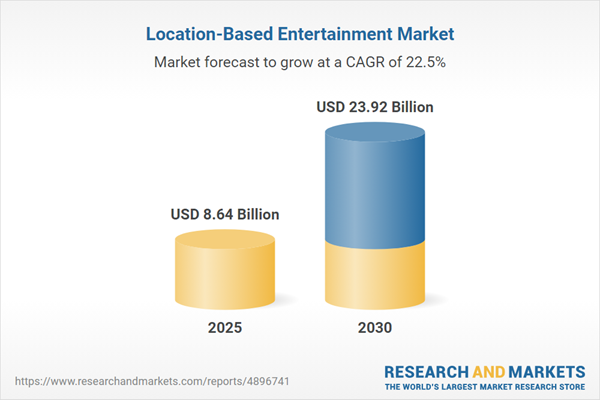Speak directly to the analyst to clarify any post sales queries you may have.
The location-based entertainment market is rapidly transforming the guest experience landscape, blending immersive technologies, advanced analytics, and creative design to deliver interactive, narrative-driven environments. As venues and operators adapt to shifting audience expectations, this market presents new opportunities and operational challenges for growth-oriented decision-makers.
Market Snapshot: Location-Based Entertainment Market Overview
The Location-Based Entertainment Market grew from USD 7.07 billion in 2024 to USD 8.64 billion in 2025. It is expected to continue growing at a CAGR of 22.53%, reaching USD 23.94 billion by 2030. This growth reflects rising demand for interactive amusement options powered by augmented reality, projection mapping, and cloud-connected simulation platforms. The sector is expanding beyond traditional paradigms, with diverse applications across theme parks, arcades, museums, sports venues, and cultural centers. Operators are increasingly adopting data-driven personalization and modular technology architectures to meet evolving guest expectations and drive competitive differentiation.
Scope & Segmentation
This report provides a comprehensive analysis spanning multiple components, technologies, venue types, business models, experience categories, and applications across key global regions.
- Component Categories: AR & VR accessories, arcade and gaming machines, audio and spatial sound systems, motion simulator modules, projection and display screens, sensors, consulting and integration services, customer support and technical assistance, game hosting and maintenance, analytics and data management, content creation and game development, content management, booking and CRM platforms, simulation platforms, and system control and integration solutions.
- Venue Types: Theme parks, water parks, arcades, museums, zoos, indoor sports halls, stadiums, and cultural centers.
- Technologies: Cloud merged reality, augmented reality, virtual reality, 3D, 4D, and 5D projection mapping.
- Business Models: Pay-per-use and subscription or membership-based approaches.
- Experience Types: Dimensional cinematic attractions, immersive storytelling, and interactive games.
- Applications: Educational and edutainment, gaming and eSports, historical and cultural showcases, and science and exploration experiences.
- Regional Coverage: Americas (United States, Canada, Mexico, Brazil, Argentina, Chile, Colombia, Peru), Europe, Middle East & Africa (United Kingdom, Germany, France, Russia, Italy, Spain, Netherlands, Sweden, Poland, Switzerland, United Arab Emirates, Saudi Arabia, Qatar, Turkey, Israel, South Africa, Nigeria, Egypt, Kenya), Asia-Pacific (China, India, Japan, Australia, South Korea, Indonesia, Thailand, Malaysia, Singapore, Taiwan).
Key Takeaways for Senior Decision-Makers
- Immersive audience engagement is evolving from passive viewing to participatory experiences, integrating storytelling, interactive gaming, and tailored education.
- Successful operators are forming strategic alliances with technology vendors and content creators, enhancing both creative delivery and system interoperability.
- Cross-disciplinary talent pools, including software developers, creative directors, and guest analytics specialists, are essential for agile innovation and competitive advantage.
- Personalization and modular technology adoption drive sustained guest satisfaction and efficient expansion of immersive offerings.
- Regional development strategies must reflect differences in infrastructure maturity, regulatory factors, and diverse cultural preferences to optimize investment and growth.
Tariff Impact: Navigating Supply Chain and Cost Considerations
Recent changes to United States tariff schedules have increased complexities within equipment supply chains. Elevated import duties on hardware components are prompting procurement teams to adjust supplier networks and explore alternative sourcing. Service providers are updating fee structures and support contracts to address shifting cost bases, while solution vendors are recalibrating investments in localization and regional support to maintain guest satisfaction and operational innovation. Collaborative supply chain mapping and vendor management are critical to minimizing disruption.
Methodology & Data Sources
This report integrates insights from primary research, including qualitative interviews with venue operators, technology providers, and service vendors across regions. Quantitative analysis covers deployment timelines and integration challenges, while secondary sources such as industry publications and regulatory reports inform broader context and supply chain perspectives. Data validation and cross-verification ensure robust, actionable intelligence for the location-based entertainment market.
Why This Report Matters
- Enables stakeholders to benchmark opportunities, risks, and innovation pathways in the evolving location-based entertainment sector.
- Provides actionable recommendations for operational agility, cross-functional alignment, and technology adoption within immersive venues.
- Helps identify optimal strategies for regional market entry, tariff mitigation, and enhanced guest engagement outcomes.
Conclusion
As the market advances, the interplay of technology, creative content, and regional strategies is reshaping audience experiences. Effective leadership and agile partnership models will position organizations to thrive and lead in location-based entertainment.
Additional Product Information:
- Purchase of this report includes 1 year online access with quarterly updates.
- This report can be updated on request. Please contact our Customer Experience team using the Ask a Question widget on our website.
Table of Contents
3. Executive Summary
4. Market Overview
7. Cumulative Impact of Artificial Intelligence 2025
Companies Mentioned
The companies profiled in this Location-Based Entertainment market report include:- 4Experience sp. z o.o.
- AEON Fantasy Co.,Ltd.
- Apple Inc.
- CyberGlove Systems LLC
- Falcon’s Beyond Global, Inc.
- Fantawild Holdings Inc.
- Fennec Labs Ltd.
- Google LLC by Alphabet, Inc.
- Habo Studio Inc.
- HOLOGATE GmbH
- HQ Software
- HTC Corporation
- Huawei Technologies Co., Ltd.
- IMAX Corporation
- Kabum s.r.l.
- Kingsmen Creatives Ltd.
- Magic Leap Inc.
- Meta Platforms, Inc.
- Microsoft Corporation
- NBCUNIVERSAL MEDIA, LLC
- Niantic Inc. by Scopely, Inc.
- NVIDIA Corporation
- Oxford Metrics plc
- Panasonic Holdings Corporation
- Samsung Electronics Co. Ltd.
- Sandbox VR, Inc.
- Sony Group Corporation
- SpringboardVR by Vertigo Studios B.V.
- Tencent Holdings Ltd.
- The VOID LLC
- The Walt Disney Company
- Zero Latency Pty Ltd.
- Zooom Studios
Table Information
| Report Attribute | Details |
|---|---|
| No. of Pages | 183 |
| Published | November 2025 |
| Forecast Period | 2025 - 2030 |
| Estimated Market Value ( USD | $ 8.64 Billion |
| Forecasted Market Value ( USD | $ 23.94 Billion |
| Compound Annual Growth Rate | 22.5% |
| Regions Covered | Global |
| No. of Companies Mentioned | 34 |









